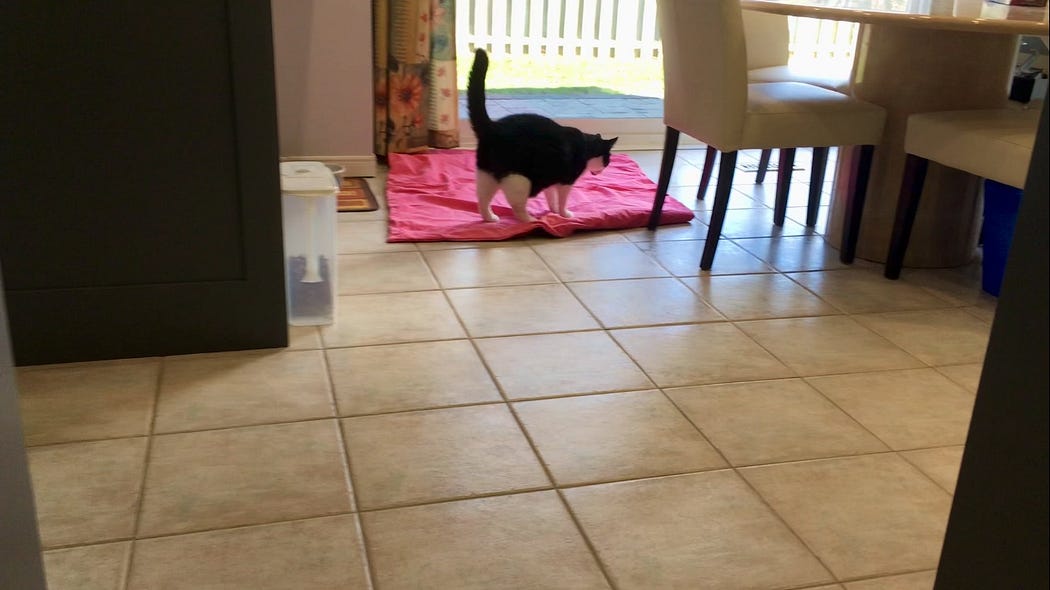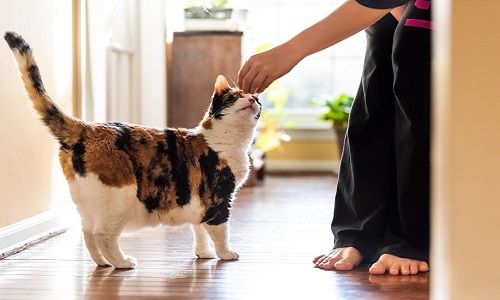My 5 Minute Training Plan For A Cat To Learn “Stay”
When Melo the cat escaped from his family’s home, he got out from the back door.
The back door is located in the kitchen.
Which was where I began formulating Melo’s anti-door-dash training plan.
I thought about the sounds preceding Melo’s back door opening.
After assessing Melo’s kitchen, I considered Melo’s perspective.
The order of operations allowing a back door exit involved the following sounds:
1) The glass door latch getting flipped
2) Sliding of the glass door
3) Flipping of the screen door latch
Since we were indoors, I focused on the sound created when the glass door latch was flipped.
Which made a “click” noise.
Previously, the “click” meant freedom to Melo.
I planned to counter-condition the click into triggering a brilliant stay behaviour that was entirely Melo’s choice.
To do that, I created value for a location to become Melo’s default “stay” area.

As an animal welfare advocate, I am committed to using positive reinforcement in my work.
Because of my functional limitations, I use a lot of shaping to teach behaviours to animals.
My hand dexterity disability from MS means I can’t use luring or a clicker.
Day 1: Paw Targeting
Total time: 90 seconds — blanket from full-sized to 1/4 size
Paw targeting means teaching a cat to use his paws to touch something.
If you’re a cat owner (slave), you know you have to make that behaviour the cat’s idea.
With paw targeting, I started with a huge surface area using a blanket.

I placed the blanket close to a wall, which served as a barrier for Melo.
Once Melo touched a single paw on the blanket, I marked the exact moment by saying “search” and throwing a piece of kibble away from the blanket.

Because Melo is a domestic cat and a hunter by nature, the view of the flying kibble drew his attention and he followed it.
Melo’s facial expression suggested he was thinking: “What? I walked on the blanket like I wanted to…and a piece of kibble got thrown.”
Then Melo put two paws on the blanket, exactly what I wanted him to do.
When I saw those paws hit that blanket, I threw another piece of kibble after saying “search.”
Melo became hooked on this game — he quickly decided that all of his paws on the blanket might be a good idea.
Precisely what I wanted him to do.
To Melo, that was his idea.
I didn’t leave the game at that.
I folded the blanket in half to see if Melo understood where the value was.
Since the half-blanket remained in the same spot as the full one, Melo decided to try putting all of his paws on this reduced surface.

Again, Melo chose to do what I wanted him to do.
After that, I folded the blanket more to create a quarter blanket.
At that point, Melo decided to sit on the quarter blanket.

For Melo, everything he did was his idea. Plus he received payment for doing those things.
What a win for a cat!

Day 2: Advancing Paw Targeting
Total time: 60 seconds
For this, I placed the quarter blanket into a basket.
Which would become Melo’s “stay” place.
The blanket within the basket was the spot I wanted to become Melo’s “stay” place.
To set Melo up for success, I started with part of the blanket hanging out of the basket.

Eventually, I had built enough value that Melo chose to go inside the basket on his own.
Where he remained.

Day 3: Adding the Cue
Total time: 13 seconds
Since I wanted the flip of the back glass door latch to be the “stay” cue for Melo, I threw a piece of kibble for him to leave the blanket in basket.
To set Melo up for success, I moved the stay zone closer to the glass door latch because I wanted him to associate the sound of the door latch with “get into your basket.”
The distance I tossed the food was close enough to his future “stay” zone. When Melo left to seek that piece of kibble, I manually flicked the door latch right before he settled himself into the basket.
After a few kibble tosses with “search,” Melo understood that door latch flick meant getting into his stay zone.
Day 4: The Release Cue
Total time: 7 seconds
A release cue is a word that permits an animal to leave a physical position or location.
Melo already had a release cue: “Search.”
Which began on Day 1 with the Paw Target game.
Melo understood “search” meant he was correct and to look for a piece of food on the ground.
I changed the release cue by introducing a new word: “break.”
Senior Cat Release Word From Place #cat #cute #cattraining #seniorcat #stay #pets
Day 5: Reinforcing Duration
Total time: 10 seconds every day
From Day 1, I dropped single kibbles when Melo was on the blanket.
Once I moved the blanket into the basket, the kibble dropping occurred unpredictably.
Since he had learned the release word “break” on Day 4, I would randomly say “break” to let him know that his job was over and that he could leave his spot.
The one time Melo was incorrect was when I put the empty basket in the living room 🤣

